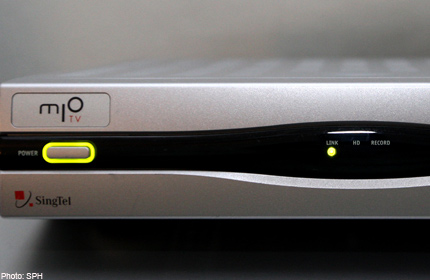- Joined
- Aug 29, 2008
- Messages
- 26,761
- Points
- 113
On hold: Plan for fewer set-top boxes

By Adrian Lim
my paper
Tuesday, May 29, 2012
The Government has pulled the brakes on a project to do away with multiple set-top boxes for pay-television shows.
Under the plan, proposed in 2009, consumers would just need one "common-featured set-top box" to access video content delivered by different service providers, on the fibre-optic Next Generation Nationwide Broadband Network.
For example, a SingTel mio TV subscriber who wants to watch shows on StarHub would not need to get a separate set-top box from the latter.
However, the Infocomm Development Authority of Singapore (IDA) and the Media Development Authority (MDA) said yesterday that the joint initiative by both the authorities will be halted, for the moment.
IDA and MDA had launched a Request For Proposal for the initiative in September 2010, but said yesterday they will not award the tender to any of the three bidders - M1, SingTel unit SingNet and StarHub.
The authorities declined to go into details of the bids but said "none of the bids is likely to achieve the desired outcomes of minimising inconvenience to consumers". Still, IDA and MDA said the project might be restarted in the future, but not in its current form.
Proposals had to fulfil commercial, operational and technical criteria, including how consumers would be charged between service providers and common pay-TV standards.
With the common-featured set-top box, barriers of entry for new content providers were expected to be lowered, as they will not need to bring in their own set-top boxes.
To ease the problem of consumers owning multiple set-top boxes to watch content which one provider has exclusive rights to, MDA announced a cross-carriage measure in March 2010 in which exclusive pay-TV content acquired by a service provider must be available on the platforms of others.
While StarHub and SingTel have worked out a way to do this without subscribers getting another set-top box to watch exclusive shows signed after the MDA measure kicked in, it does not apply to other types of content, like non-exclusive shows.
The common-featured set-top box would have been able to address this issue.
M1 said it was "disappointed" that the plan did not go through, but the preparation for the bid has put it in "a good position" to source its own pay-TV content.
SingTel and StarHub said they would explore new ways to deliver their content and services.

By Adrian Lim
my paper
Tuesday, May 29, 2012
The Government has pulled the brakes on a project to do away with multiple set-top boxes for pay-television shows.
Under the plan, proposed in 2009, consumers would just need one "common-featured set-top box" to access video content delivered by different service providers, on the fibre-optic Next Generation Nationwide Broadband Network.
For example, a SingTel mio TV subscriber who wants to watch shows on StarHub would not need to get a separate set-top box from the latter.
However, the Infocomm Development Authority of Singapore (IDA) and the Media Development Authority (MDA) said yesterday that the joint initiative by both the authorities will be halted, for the moment.
IDA and MDA had launched a Request For Proposal for the initiative in September 2010, but said yesterday they will not award the tender to any of the three bidders - M1, SingTel unit SingNet and StarHub.
The authorities declined to go into details of the bids but said "none of the bids is likely to achieve the desired outcomes of minimising inconvenience to consumers". Still, IDA and MDA said the project might be restarted in the future, but not in its current form.
Proposals had to fulfil commercial, operational and technical criteria, including how consumers would be charged between service providers and common pay-TV standards.
With the common-featured set-top box, barriers of entry for new content providers were expected to be lowered, as they will not need to bring in their own set-top boxes.
To ease the problem of consumers owning multiple set-top boxes to watch content which one provider has exclusive rights to, MDA announced a cross-carriage measure in March 2010 in which exclusive pay-TV content acquired by a service provider must be available on the platforms of others.
While StarHub and SingTel have worked out a way to do this without subscribers getting another set-top box to watch exclusive shows signed after the MDA measure kicked in, it does not apply to other types of content, like non-exclusive shows.
The common-featured set-top box would have been able to address this issue.
M1 said it was "disappointed" that the plan did not go through, but the preparation for the bid has put it in "a good position" to source its own pay-TV content.
SingTel and StarHub said they would explore new ways to deliver their content and services.


